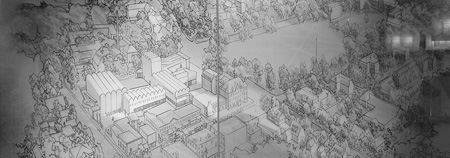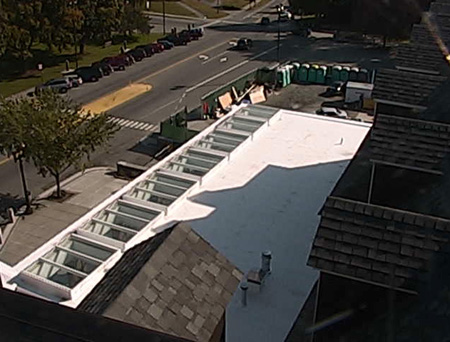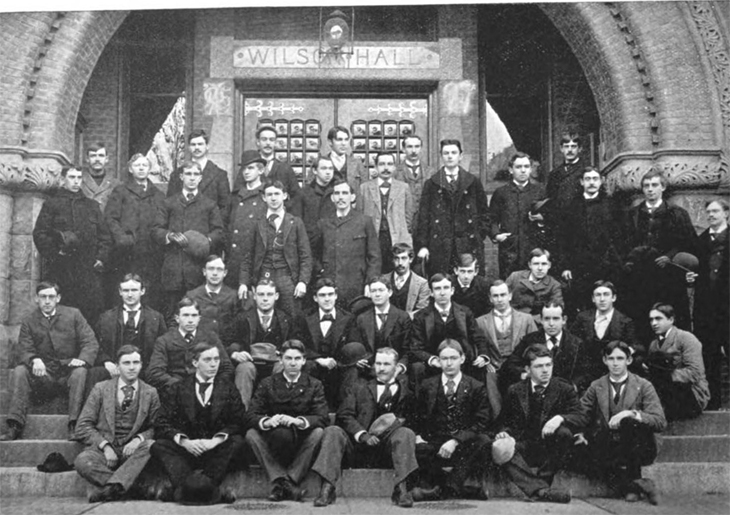- DADA (Dartmouth Alumni in Design and Architecture) is having its third alumni architecture exhibit June 6 through 16 in the Nearburg Arts Forum in the Black Family Visual Arts Center (via Sue).
- The Big Green Alert Blog reports that the Town has approved the zoning amendments that will allow a new video scoreboard at Memorial Field (a topic about which alumni are fairly passionate, judging from the comments on a post at this blog). The Zoning Board was to have considered a request for a Special Exception to replace the existing scoreboard at Scully-Fahey Field in its hearing on May 30 (ZBA Agenda).
- The Rauner Library Blog has a post about old postcards depicting the campus.
- The Dartmouth published a series of three articles on architecture last month. First, “Despite lack of major, architecture offerings abound” suggests again how interesting a history of the somewhat hidden world of design education at Dartmouth would be; second, “Recent campus buildings depart from New England tradition” focuses on post-1984 work; and third, “College’s early buildings share traditional aesthetic” covers prewar buildings (thanks to Amanda for the quotes).
- Dartmouth Now article (and Flickr set) on the Life Sciences Greenhouse atop the Life Sciences Center.
- The Planner has photos of the new offices of Dartmouth Computing in Baker, the new deans’ offices (Student Academic Support Services) in Carson, in a space formerly occupied by the Computer Store (Planner’s Blog post), and the new location of the Computer Store in McNutt. This confusing shuffle was mentioned on this blog during April. Any word on the fate of the old Kiewit space outside the Tower Room?
- The Planner also has photos of 113 Wilder, the Physics Department’s office and lounge suite.
Category Archives: publications
The new campus map
The new campus map is available to mobile devices from the Dartmouth Mobile website (Dartmouth Planning announcement). The new map is better-looking than the current map, a pdf released in August of 2010 (Flash version). The society names are spelled out in Roman type, eliminating the orthographic creativity that rendered “ΦΔΑ” as “FDA” on the current map.
Because it’s electronic, this new map has a fantastic scope. Zooming out will display everything from the hospital to the Organic Farm, and the map’s coverage includes nodes for the airport and the Skiway. The Morton Farm equestrian center is included within the known world as well.
Who dares wins: graduate studies proposals
One of the Strategic Planning reports suggests that Graduate Studies be given a lounge:
The lack of any identifiable social space on the Dartmouth campus is quite striking, in comparison to all our peer institutions who have endowed graduate student centers. The ideal location for this space would be near the center of campus so that it would be easily accessible and also a visible reminder of the presence on graduate students and research on the campus.
(Graduate Education for the Future Working Group Final Report (June 2012), 13.) This desire has surfaced previously in the inclusion of a graduate suite in the original proposal for a ’53 Commons north of Maynard Street (pdf).
Compare this idea proposed by a different working group (WG) focused on research, scholarship, and creativity (RSC):
To meet all these goals, our WG recommends that Dartmouth consider the formation of a new school, the first in over 100 years. The School of Advanced Studies (SAS) would be the first-in-the-nation school focused broadly on advancing RSC for faculty, graduate students, post-doctoral fellows and undergraduates. Led by a new Dean reporting directly to the Provost, SAS’s remit would be to advance RSC at Dartmouth across all disciplines and all schools. It would invigorate the research environment at Dartmouth, spearhead better organized decisionmaking on RSC, help attract top talent to Dartmouth from all over the world, create more inclusive and enriching environment for graduate students and post-docs, and foster crossdisciplinary collaboration among faculty as well as undergraduate, graduate and post-doctoral students. We envision a new facility on central campus that would house SAS and its associated programs, as well as housing for visiting scholars and conference attendees, conference space, and common spaces.
(Research, Creativity and Scholarship Working Group Final Report (June 2012), 5.)
This sounds a bit like the famous Institute for Advanced Study, which occupies a Jens Larson building near Princeton University, but that organization is independent of its local university (see also Wikipedia).
Polton speaking on F.W. Wentworth
Richard Polton, author of the book on alumnus architect Fred Wesley Wentworth, will speak about Wentworth at C&G on February 26 at 5 p.m. (via Becky). The event will be sponsored by ARC@D and DADA.
Wentworth designed the Casque & Gauntlet library addition about 100 years ago.
The Black Family Visual Arts Center as presented by Machado & Silvetti
The designers’ official page is now available and includes dozens of images.
The firm has provided a placeholder page on its website for more than six years.
Another old elm felled; other news items
- The elm tree in front of Collis has been cut down (the Planner’s Blog). The tree stood north of the northwest corner of Main and Wheelock, as shown in the Google Street View image above.
- Adrain Dater reminisces about the early days of Thompson Arena at DartmouthSports.com.
- A Valley News article on two guys from Pike, N.H. who were going to the World Series of Beer Pong in Las Vegas explains the game but strangely does not mention Dartmouth, even to distinguish “beer pong” from “pong.”
- The Alumni Relations Office presents a photoset showing A History of Dartmouth in 20 Objects.
- The Valley News reports that the Lebanon Planning Board has delayed its approval of a 162,970 square foot research building at the hospital complex. The problem is traffic. (It is not clear whether this is the building formerly or presently called the Williamson Translational Research Building.) (Update: It is the Williamson according to the Union Leader.)
- The new Dartmouth website makes more and better use of the coat of arms than did the old site. A white outline of the shield is combined with text atop photographs on the President-Elect’s site (in this image) and at least one detail of a portion of the shield is blown up and used as a background in other places (in this image, reminding one of the current fifty-pence coin).
- Inside Higher Ed has an article on how the for-profit Grand Canyon University is preparing to field a Division I basketball team. Fascinating.
- President-Elect Hanlon, in his roles in planning and finance at Michigan, very likely worked with Venturi, Scott Brown & Associates. The firm was brought to Michigan by then-president Lee Bollinger, Dartmouth’s former provost, and designed a campus plan (2002) and life sciences complex (2003, 2005).
- City Prints produces an arresting Dartmouth map.
- “Dartmouth is, after all, not so much a college as a collection of stories about a college.” David M. Shribman and Jack DeGange, Dartmouth College Football: Green Fields of Autumn, 8.
—–
[Update 01.27.2013: Williamson identity information added.]
A new online map of the campus is in production
The Office of Planning and Design and the Office of Public Affairs are putting together a new post-Flash online campus map (the Planner’s Blog).
The sample map provided looks promising: the society names have been corrected (“AZD” is “Alpha Xi Delta”) and the obscuring blue triangles indicating accessible entrances have been removed. Because the map will be on line, the accessibility information can remain hidden until a particular area is moused over (or tapped on a mobile device? Lots of possibilities here).
The Riverfront Master Plan
The College Planner has made available long-term proposals of the Riverfront Master Plan (pdf) by Milone & MacBroom of Waterbury Vt.
The plan contains several intriguing ideas:
- New buildings behind and next to (north of) the Friends Boathouse.
- The expansion of the Fuller Boathouse and the rebuilding or removal of the singles shed next to Fuller.
- An addition to Ledyard Canoe Club (one hopes it is an addition: it could be a replacement) and the removal of the three boat sheds behind Ledyard.
- On Tuck Drive, a Sewer Pump House.
- The transformation of much of the current large parking lot into parkland.
The diminishing supply of Connecticut brownstone and other topics
- It is easy to forget that the Rufus Graves who was extremely involved in the college and the town — and who built the first bridge over the river at Hanover — is the same Rufus Graves who was central in the founding of Amherst College (Amherst bio).
- The New York Times has an article on the closing of the last Connecticut brownstone quarry. The remarkable part of the story is not to much that Portland Brownstone Quarries is closing, but that any of the quarries ever reopened once they closed during the 1940s. (This one apparently reopened during the mid-1990s.) Brownstone was used to entirely cover some collegiate buildings, such as Wesleyan’s Fisk Hall, but it does not seem to have been as popular as red brick and limestone. Harvard might be to blame. It is worth noting that brownstone was a popular trim material for Romanesque buildings, such as Bartlett and Wilson Halls at Dartmouth.
- The Boston Globe has “a series of New England getaways on public transportation,” and the latest number features idyllic Hanover, New Hampshire. It is good to learn about new restaurants that have sprung up, but it is easy to quibble with the use of “College Green” as a (Dublinesque) place name.
- One need no longer concern oneself about the faux-antique spelling of the name of the restaunt at “5 Olde Nugget Alley.” The building is now occupied by 3 Guys Basement Barbecue (see the restaurant site, PigTrip review).
- There is some neat rephotography on the master planning website. (See Shawn Clover’s remarkable composite images of the San Francisco Earthquake, then and now. Via Slate.)
- The Valley News on the extension of the rail trail to connect downtown Lebanon and West Lebanon.
- Low-angle or oblique aerial photos of Hanover: there are now many available. Lakes Region Aerial Photo has a good collection. Air Photo North America has a few with the Shower Towers still standing after Kemeny was finished. Aerial Design has lots of photos, including winter shots. Then there is this nice overall view published by Thayer School.
- The College Planner’s blog has seen a lot of activity lately.
- Thanks to Bruce for the mention on the Big Green Alert Blog. Both the team and the coverage are particularly exciting this year. Thanks to Kevin G. Quinn for the cite to the Old Division Football paper in Sports and Their Fans: The History, Economics and Culture of the Relationship Between Spectator and Sport (Mcfarland, 2009), 235. Thanks to the master planning staff for the cite to the Campus Guide in the history section of the master planning site.
Ross Ashton’s Five Windows
The Dartmouth quotes Ross Ashton on his projection, “Five Windows,” which premiered last month:
It’s about a sense of space and place. I always hope that people will see the building in a new way, and I hope to reintroduce the architecture in a new way. The intent is to bring back the history and impact the building had at the time it was made.
Ashton placed white sheets in the tall front windows of the Hopkins Center to provide a projection surface. The town closed down Wheelock Street in front of the Hop during the display.
Dartmouth Now writes:
The projection draws upon both archival and recent images and videos of the Hop, including blueprints and schematic drawings from the planning of the building; photos of the construction and inauguration, including then Dartmouth President John Sloan Dickey atop a front-loader taking a ceremonial first scoop of earth at the site; posters from throughout the Hop’s five decades; and footage from student performances.
See some snippets in this video (via Dartbeat). More information is at Artdaily and Ross Ashton’s website.
The Black VAC film
In the school’s official video, the shots of the Visual Arts Center start at 3:19. Several of the shots of the rooftops of the Hop appear to have been made with a radio-controlled helicopter: a private drone surveils Hanover.
In the section of the film called The Builders [8:04], the emphasis is on cross-disciplinary work. That was one of the original goals of the Hopkins Center as well, but now that the visual arts have moved to their own building, the Hop seems to be left with just the performing arts for cross-pollination.
Ken Burns has a nice quotation: Art “turns out to be the bright burning sun of this particular solar system called Dartmouth.”
Alex Hanson’s thorough article in the Valley News adds yet another possible name to the hat: The Black VAC.
Dartmouth has an announcement of the installation and one-year loan of Crouching Spider.
The school’s master planning site is up
The blog that will be the focus of the outreach effort is up, and it links to the actual master planning website.
One of the initial posts at the blog has a link to the 2003 video When Dartmouth Builds (cf. “When Smokey Sings“).
Another post links to the large online collection of maps of Hanover maintained by the Evans Map Room. One item is a group of 43 topographic maps from stadia surveys of Hanover made by the Thayer School classes of 1903 to 1920, and the maps are amazing. The Larson-era plans for the development of the campus are both thrilling and frightening (ca. 1923?, 1928).
——
[Update 11.04.2012: Link to planning website added.]
Another odd use of history, at Six South
The welcome addition of a new hotel in town, Six South Street, has raised interesting questions about the uses of history and college nostalgia. The place is new and sophisticated, but it needs to appeal to the green plaid pants crowd. It was presumably for this reason that the hotel’s decorators put a large drawing of Hanover in the early 1960s on one wall of the lobby (from the hotel’s appealing website):

The drawing was done by Aldren A. Watson in 1964 and a version of it was published in the back endpapers of Ralph Nading Hill’s book College on the Hill. Rauner Library holds the original drawing and the Trustees hold the copyright.
The hotel must have its reasons for displaying a drawing that emphasizes the Hanover Inn and omits South Street. But why reverse the view? Yes, this view is backward: the lobby decoration, which appears elsewhere on the hotel’s website, puts Dartmouth Row on the west and Mass Row on the east. [Update: The image is on glass and is oriented properly when viewed from the other side.]

—–
[Update 04.23.2014: The Watson image is etched on glass and is correct when seen from the Media Room; note added.]
A Passion for Snow and other notes
- Here in Hanover ran a profile of architect Randall Mudge in its Spring 2011 issue (pdf).
- David’s House at CHaD is adding a wing (Valley News).
- This unusual stucco house at 28 East Wheelock has a whiff of Larson about it; it is owned by the college (see Dartmouth Real Estate):
- A trailer for the upcoming Dartmouth ski documentary A Passion for Snow is available.
- A map art company is selling a print of a stylized map of the campus.
- Something big has happened to 8 Occom Ridge:
The later aerial views from Google and Bing (below) appear to show a replacement:
- A Dartmouth shirt sold on eBay says “Go Green and White.” Hmmm.
- The Development Office has its own in-house PR firm, the Office of Development Communications.
- An article on archeology in Columbia, Connecticut explains that the first building of Moor’s Indian Charity School still stands, on a later foundation.
- Both the renovated Hanover High and the new Richmond Middle School have biomass plants. It is hard to imagine that any future Dartmouth heating plant would not rely at least in part on burning wood chips.
- The Dartmouth Planner reports that the Town of Hanover is beginning to rewrite its zoning ordinances.
- Last spring, van Zelm Heywood & Shadford helped renovate Burke Chemistry Laboratory (The Dartmouth).
- A recent photo of the roof of the expanded Hayward Room at the Inn, taken with the Class of 1966 Webcam:

Academic Center cutaway
KSWA has published a view of a cutaway model. The firm explains:
The new Dartmouth North Campus Academic Center, currently in Design Development, is organized like a small village. Two-storey office “Community Spaces” step down from both ends to a Forum and Cafe as “Town Hall,” which opens to a “Town Center” in the form of an outdoor plaza.
Minary room plans published
The Inn has published floor plans (pdf) for the Minary Conference Center within the building. Bill Rooney Studio has posted interior designs, Cambridge Seven also has a new project page with a couple of photos of the completed work, and Here in Hanover1The fall issue (pdf) also has articles on Shattuck Observatory; a book-shaped granite sundial sculpted by Dartmouth alumnus Bill Nutt and donated to Linacre College, Oxford, by retired DMS professor and Linacre graduate Frank Manasek, author of Study, Measure, Experiment; King Arthur Flour; builder Peter French; and the new Dartmouth ski history documentary Passion for Snow. has a well-illustrated2The computer shown in the photo on the second page is curious: although one can substitute colored components on a Mac laptop, the body is machined from a single billet of aluminum. Somehow the sides of this computer were colored red without the surfaces around the ports and keyboard also being colored. Decals, perhaps? article on the Inn (pdf).
The smaller rooms have familiar names (Hayward, Drake, Ford Sayre), and the larger ones have the logical names Grand Ballroom, Ballroom East, and Ballroom West.
The Grand Ballroom, which occupies the old Zahm Courtyard space at the level of the lobby, measures 57 x 69 feet. This room is part of the third phase of the project and will open during November. One of the architects’ renderings of the new Hop entrance in the Zahm Courtyard, below the ballroom, showed the words “COLLEGE ENTRANCE” above the doors. It will be interesting to see whether the building ends up saying “HOPKINS CENTER” or perhaps nothing at all.
——
| ↑1 | The fall issue (pdf) also has articles on Shattuck Observatory; a book-shaped granite sundial sculpted by Dartmouth alumnus Bill Nutt and donated to Linacre College, Oxford, by retired DMS professor and Linacre graduate Frank Manasek, author of Study, Measure, Experiment; King Arthur Flour; builder Peter French; and the new Dartmouth ski history documentary Passion for Snow. |
|---|---|
| ↑2 | The computer shown in the photo on the second page is curious: although one can substitute colored components on a Mac laptop, the body is machined from a single billet of aluminum. Somehow the sides of this computer were colored red without the surfaces around the ports and keyboard also being colored. Decals, perhaps? |
Revealing the spaces within Wilson Hall
Billie Tsien, in an interview in the latest Hood Quarterly (pdf):
After walking through Wilson Hall, I just can’t wait to clean out everything and take a look at the bones. There are some incredibly beautiful and very powerful spaces in Wilson Hall, and stripping it down will help us to see, for example, the height of the top floor and the skylight. People are really just going to be blown away.
This 1894 photo shows the building’s front entrance.

“Goat Room” and other terms
- A thorough post on the use of goats in fraternity imagery covers the use of the term “goat room” to describe a meeting room. That term has been used a number of Dartmouth houses including Tri-Kap, Beta Theta Pi, Phi Gamma Delta, Zeta Psi, Sigma Nu, and Psi Upsilon. The first Goat Room built by Beta is visible at the far right of a photo on the Town’s Flickr photostream.
- Bob Donin’s 2011 oral history interview with William Jenkins ’43 and his wife Mary contains these linguistic observations on page 18:
MARY: […] And the other thing that’s interesting—and I’ve talked about this to my few good friends who are still around who grew up here—when we said campus, we meant the Green. And it was never called the Green.
DONIN: Oh, it wasn’t called the Green back then?
MARY: Well, at least not by any of us. Never used the word Green. And when we said campus, which was an incorrect use of the word obviously, we meant the Green. I’ll meet you on campus. I’ll meet— you know, use it in that context. And it’s very interesting to see the evolution. And another thing that’s different: When you were in college and I was dating and stuff, the word “frat” was considered to be a state university word, and everyone looked down their nose at it, and they never under any conditions would use the word “frat,” meaning fraternity. And now it’s I think commonly used.
DONIN: So what did you call—oh, you called it a fraternity.
MARY: A fraternity. Or by the Greek name.
- A Valley News blurb refers to plans “for a six-story addition just south of the main entrance” of DHMC, for research. Presumably this is the Williamson Translational Research Center.
- A nice history of the building of the Ray School.
- A new Maine Heraldry Blog is promising. Go moose-deer!
- Rauner Library is allowing visitors to lick one of the books in its collection.
- Thanks to Robert Goodby for citing the Notes toward a Catalog… in the 2006 Lebanon Slate Mill conservation study (pdf). Thanks for the citations to Halls, Tombs and Houses by Blake Gumprecht in The American College Town (UMass Press, 2010) and Carole Zellie in the University of Minnesota Greek Letter Chapter House Designation Study (2003). Glad the Review has adopted this site’s analysis of the new Inn addition.
- Brilliant. Another post in praise of the aerial photo provided by Bing:
——-
[Update 11.04.2012: Beta photo link added.]